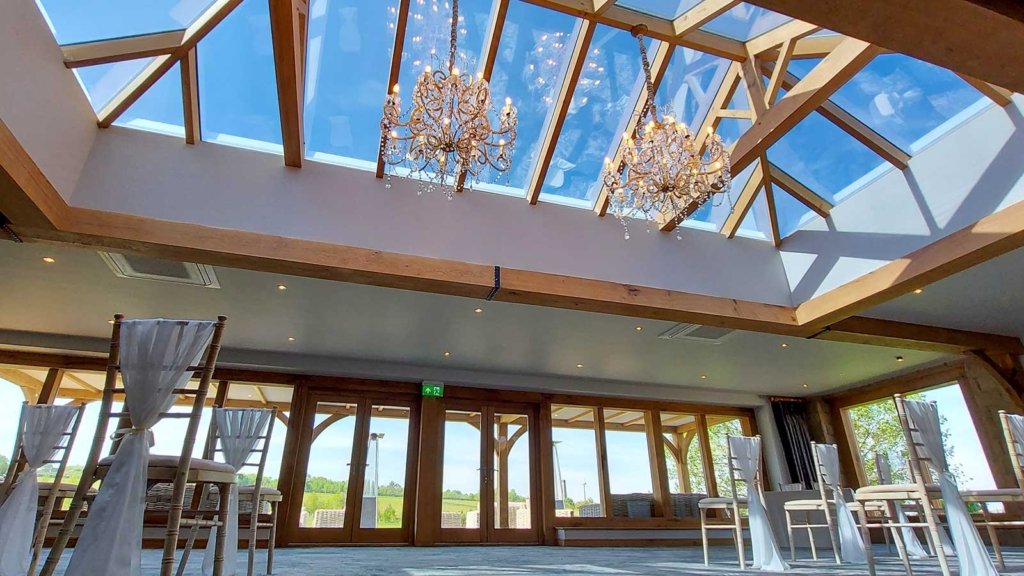
oakbydesign
01423 593 794



Roof lanterns have become an increasingly sought-after architectural feature, thanks to their ability to enhance natural brightness and add value to any project. These meticulously designed structures, especially on oak orangeries, offer up to three times more daylight than standard roof lights, flooding the space with natural light and creating a warm and inviting atmosphere.
However, before delving into the world of roof lanterns, it’s crucial to navigate the maze of planning permission requirements. Additionally, selecting the right frame and glass types is paramount to achieving both visual appeal and optimal thermal efficiency.
Furthermore, budgeting for a roof lantern involves considering various factors such as size, glazing specifications, and additional features.
In this guide, we will explore the benefits, planning considerations, and technical aspects of roof lanterns, ensuring that you can make informed decisions when embarking on this exciting architectural journey.
Roof lanterns offer a multitude of benefits, including enhanced brightness, increased daylight, and the creation of an open and welcoming environment. Compared to standard roof lights, roof lanterns allow a greater amount of daylight to enter a space, resulting in a brighter and more vibrant atmosphere.
By strategically placing a roof lantern slightly off-centre, one can maximise the amount of daylight that filters into the room. Additionally, roof lanterns provide increased solar gain, ensuring that natural light can reach all corners of the room which is beneficial in an oak orangery. This not only enhances the overall aesthetics but also improves the mood and well-being of the occupants.
With their ability to create a warm and inviting atmosphere, roof lanterns are an excellent choice for any project seeking to maximise natural light and create a comfortable living space.
In the process of installing a roof lantern, it is crucial to navigate the requirements and regulations associated with planning permission. In most cases, roof lanterns can be installed under permitted development (PD) without formal planning permission. However, it is important to check with the local authority for any height and look restrictions that may apply.
Properties that are listed, located in conservation areas, or require significant alterations may require permission for the installation of a roof lantern. It is also important to ensure that the size and design of the roof lantern do not have a negative impact on neighbouring properties.
For those with specific requirements, some suppliers offer customised roof lanterns that can be tailored to fit individual needs.
When specifying the frame and glass types for a roof lantern, it is essential to consider the materials, aesthetics, and performance requirements of the project.
Oak and aluminium are common frame materials for roof lanterns, with each offering distinct advantages. Aluminium-framed lanterns have slim sight lines, providing a sleek and modern aesthetic while also offering superior insulation. On the other hand, oak roof lanterns installed on oak orangeries provide a classic and natural feel, often complementing period properties.
Additionally, the selection of high-quality glazing is crucial for optimal performance. Double or triple glazing should be chosen to maximise solar gain and thermal efficiency.
Having considered the frame and glass types for a roof lantern, the next crucial aspect to address is budgeting for this architectural feature. The cost of a roof lantern is dependent on several factors, including its size, glazing specification, and additional features.
When budgeting for a roof lantern, it is important to consider the desired structure style and frame material. Smaller lanterns, suitable for compact spaces, can start at around £500. Most lanterns, ranging from 1m x 2m up to 2m x 4m in size, fall within the approximate price range of £1,000-£3,000.
However, non-standard features such as automatic openings or self-cleaning glass may increase the overall cost. It is essential to have a clear understanding of the budget to ensure that the chosen roof lantern aligns with financial constraints.
Telephone: 01423 593 794
Locksley Park
Blind Lane
Tockwith
YORK YO26 7QJ
Opening Times:
Mon to Fri - 9.00am to 5.00pm
Bank Holidays - Closed
Christmas 2025- TBC
Oak By Design is the trading name of:
Oak By Design Ltd.
Reg Number: 04384416
VAT Number: 664 8012 33